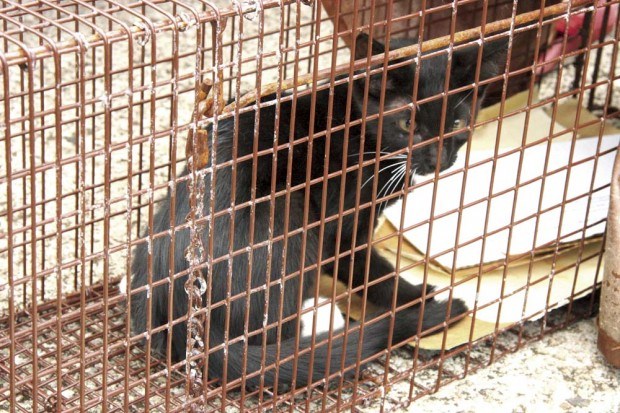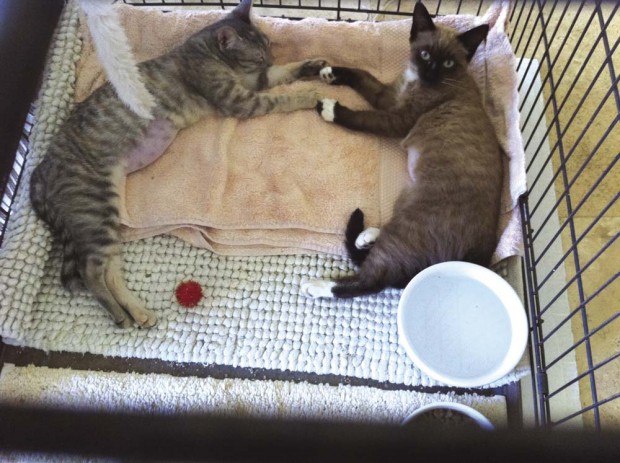To TNR or not to TNR?
NAWILIWILI — The Kaua‘i County Council on Wednesday approved a resolution supporting the trapping, neutering and return method of controlling the island’s feral cat population.
But while everyone — council members and public present — agreed that the feral cat population must be controlled, there was much disagreement on how such control should be enacted.
“By adopting this program it will be counterproductive to protect our endangered species,” said Michael Mitchell, United States Fish and Wildlife Service Deputy Project Manager for the Kaua‘i Refuge Complex.
Mitchell said a much cheaper and more successful program would be to trap and remove the cats.
Councilman Tim Bynum said he didn’t think TNR was causing a problem, and blamed the lack of addressing the problem for the increase in feral cats on Kaua‘i.
The only people who have been doing something are the “TNR folks,” he said.
Margaret Sueoka is the president of the non-profit Kaua‘i Ferals, made up of a concerned group dedicated to paring down the number of feral and homeless cats on the island through trap, neuter and return programs, according to its website.
Sueoka started the TNR program seven years ago. Despite saying she has seen a decrease of feral cats in managed colonies around the island, and that the organization keeps track of the numbers, she didn’t have those numbers available at the council meeting, but said she would be able to follow up with data later.
Sueoka said the cats deserve “some compassion,” and there are places on Kaua‘i where a managed feral cat population would be viable.
‘Alien predator’
Makaala Kaaumoana, vice chair of Hui Ho‘omalu i ka ‘Aina, said the domestic cat may be “the most widespread alien predator in the world, with devastating consequences.”
Scientists, she said, estimate that free-roaming cats kill hundreds of millions of birds, small mammals, reptiles and amphibians each year.
“I fight every single day to save the last shearwaters, and these cats are eating them, these cats are killing them,” said Kaaumoana, adding that she spends a lot of time on litigation and mitigation. “And I have cats.”
The Kaua‘i Refuge Complex consists of three refuges, according to Mitchell. The refuges include 140 acres in Hule‘ia, 117 acres in Hanalei and 202 acres in Kilauea.
Mitchell, who is also a biologist, said that between mid-2008 and mid-2009 his staff trapped 95 feral cats from the three wildlife refuges combined. He said some studies estimate feral cats eat one bird a day, which would translate to 28,500 birds killed by those 95 cats in 300 days.
Many of the cats necropsied, or autopsied, by the USFW staff, Mitchell said, had native birds inside their stomach.
“Placing those animals back in the wild is a really bad idea,” said Mitchell, adding that even a well-managed colony, where cats are fed everyday, will harbor predators, because cats will still hunt due to their nature.
A Big Island radio-tracking study showed that male cats can range up to eight square miles, and females up to three square miles, according to Mitchell, who said the range could be even larger if there is not enough prey in the area.
Kaaumoana said a peer study published February 2009 in Conservation Biology found that cats in TNR colonies continue to prey on birds and other animals.
But Sueoka had a different opinion. She said a spayed or neutered cat that is fed daily has no desire to roam at night for food.
Endangered Species Act violations
Additionally, Mitchell said that from a legal perspective, federal and state wildlife laws designed to protect endangered and threatened species conflict with the practices of releasing non-indigenous invasive predators into the wild.
“TNR practices likely violates the Endangered Species Act and the Migratory Bird Treaty Act because a TNR colony here on Kaua‘i will most likely result in the direct take of protected species, whether it be a Hawaiian duck, Newell’s shearwater, or one of the other five species of federally threatened or endangered ground nesting birds found on Kauai‘i,” he said.
Mitchell also raised concerns of Toxoplasmosis and Salmonella contamination through fecal pollution and bacterial loading of streams and coastal waters.
Kaaumoana said Toxoplasmosis transmitted from cats have caused the death of one Hawaiian monk seal on Kaua‘i, and research shows that the toxin that causes the disease can sporulate in seawater and infect other sea mammals.
4-3 vote
The resolution was approved on a tight 4-3 vote, with Council members Nadine Nakamura, JoAnn Yukimura and Chair Jay Furfaro voting against it.
Yukimura said she could not support the resolution in its current form because she thought it was an incomplete process. She said the council should “take it all the way,” get every stakeholder together, and create a feral cat advisory committee, which had been suggested by Nakamura.
“Right now it could be a (endangered species) take problem that we are endorsing,” she said.
Councilman Dickie Chang supported the resolution, but agreed that cats are natural hunters. He said his cat often brings food from the streets.
Councilman KipuKai Kuali‘i said the resolution is about education, and regardless of it passing, the county should continue to educate the community.
Furfaro said that passing the resolution leaves a “huge scope of work” to be done, which is by charter not the work of the council.
“This resolution was never intended to create a TNR program, only to raise awareness that TNR is a viable solution,” said Councilman Mel Rapozo, who introduced the resolution.
Rapozo said he thinks the mission was accomplished. “I think we raised the awareness to another level.”
Jessica Venneman, Field Services Manager at Kaua‘i Humane Society, said the organization’s goal is to assist in helping to stabilize the cat population on Kaua‘i. The nonprofit provides free spay and neuter, and will even pick up and deliver the cats, in case owners request it.
Venneman said those interested in the KHS offer can call the organization at 632-0610.
• Léo Azambuja, staff writer, can be reached at 245-3681 (ext. 252) or lazambuja@ thegardenisland.com.



